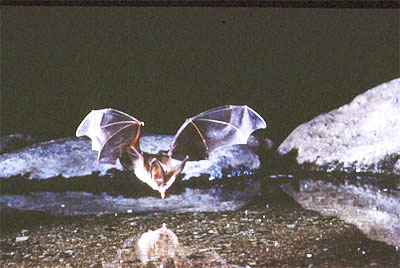
 |
| Bat Research in California |
 Photo courtesy of Merlin D. Tuttle © Bat Conservation International. |
|
Bats are very misunderstood creatures. Although there are some risks associated with
handling bats or any wild animal, they are noted for many more benefits,
such as consuming
vast numbers of insects, pollinating certain species of plants, and distributing seeds of fruits.
Like other wildlife, if handled or molested they will defend themselves by biting. Like all mammals,
bats can be carriers of the rabies virus. You should not pick up a bat that is on the ground, or touch
one that is roosting.
Scientists at the USGS Western Ecological Research Center are studying bats in the San Francisco Bay area and in southern California to provide land managers information they need regarding the occurrence and status of bat species. Survey techniques include detecting bats by their vocalizations, observing foraging bats, and capturing bats at foraging or roosting sites. These scientists regularly handle bats, but they have been trained in appropriate capture and handling techniques, and they have been vaccinated against rabies. WERC Research Related Bat Links
|
| For More Information Contact: | ||
|
San Francisco Bay area-- Gary M. Fellers Pt. Reyes Field Station Point Reyes National Seashore Point Reyes, CA 94956-9799 Phone: (415) 464-5185 Fax: (415) 464-5183 Email: gary_fellers@usgs.gov |
San Diego County-- Drew Stokes San Diego Field Station 5745 Kearny Villa Road, Suite M San Diego, CA 92123 Phone: (858) 637-6885 Fax: (858) 974-3563 Email: dstokes@usgs.gov |
|
-- WERC Home -- Who We Are -- Where We Are -- What We Do -- What's New -- Outreach -- Contact Us -- Search --
USGS Privacy Policy, Disclaimer , Accessibility